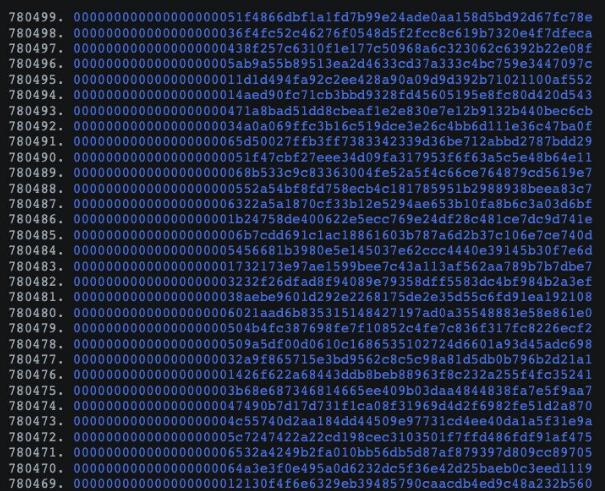What the Ethereum Merger Means for NFTs
by James · September 2, 2022

Table of Contents
ToggleIn short
- Ethereum is about to complete its long-awaited “merger” that will dramatically reduce the environmental impact of the network.
- There can be counterfeit versions of Ethereum, which can cause confusion and lead to fraud when duplicate NFT assets enter the market.
We are days away Ethereum’s long-awaited mergerwhere the leading network for dapps and NFTs will switch to a more energy-efficient system. It’s years in the making, but as the mid-September target approaches, many users are wondering what could go wrong – and whether anything will change with their owned assets.
This is especially true when it comes to NFTswith tens of millions of profile pictures, collectibles and artwork now running on Ethereum—some of whom have commanded eye-popping sums in the middle The NFT market’s progressive increase over the last couple of years. What happens to your NFTs after the merger?
The simple answer is: probably nothing. They will still be in yours wallet and should work as usual on marketplaces and within dapps. But the overall picture is more complicated than that, primarily because of the expected rise of community-led forks of Ethereum after the merger. Duplicate NFTs will appear as a result, potentially leading to confusion and fraud.
What do you need to know about Ethereum NFTs going into the merger and what might happen afterwards? Decrypt spoke with Ethereum experts about what to expect as the multi-billion dollar NFT market anticipates some expected twists ahead.
On the merged chain
The merger will see Ethereum shift from the current proof of work mining model—which requires abundant decentralized power to process transactions—to a proof of effort consensus system expected to use over 99% less energy, according to the Ethereum Foundation. It is a huge advance for Ethereum and especially for NFTs, effectively negating one of the biggest criticisms of NFTs.
As mentioned, the merger has been in the works for years, and Ethereum’s core developers have painstakingly tested each process and worked through potential issues. While there’s no guarantee that the transition will be seamless, developers and creators expect a fairly smooth process going forward.
“Ethereum is software, and all software suffers the punch problem– In other words, it is impossible to determine with certainty whether there will be any technical problems, says Eric Diep, co-founder of smart contract startup Manifoldtold Decrypt. “That said, I wouldn’t bet against ETH’s developer community.”
If all goes according to plan, however, Ethereum NFTs should work just fine on Ethereum’s newly upgraded the main network. They will still be held in your wallet(s) and will function as usual on marketplaces, and you will not need to do anything to prepare for the merge. It will all be handled on the developer side to hopefully ensure a seamless transition.
“Users should expect that their NFTs will be safely located on the new Ethereum [proof-of-stake] chain together with their ETH tokens,” confirmed Johnna Powell, NFT co-head at Ethereum-centric software company, ConsenSys.
Forked considerations
While most of the Ethereum community seems on board with the merger and its potential benefits, there are notable detractors. Some Ethereum supporters do not want the chain to shift away from proof-of-work miningeither because of the security benefits of the energy-intensive process or the rewards earned by miners operating the data rigs.
As a result, some developers in the Ethereum community plan to fork the blockchain and create a spinoff chain that continues with the current proof-of-work system. The most prominent example to date is called ETHPOWled by well-known Chinese miner Chandler Guo.
ETHPOW will not be the same as Ethereum’s merged mainnet. It will be somewhat similar to how Ethereum itself forked away from its original chain in 2016 to deal with fallout from The DAO hack, and some users continued to support the original chain under the new name, Ethereum Classic. But a lot has changed since then and there are many more assets – including NFTs.
As ETHPOW and other forks spin off Ethereum’s mainnet, they will provide duplicate versions of Ethereum’s NFTs. An NFT is simply a blockchain token, and it can act as an ownership of digital objects such as works of art and collectibles. A forked Ethereum chain will thus have duplicate joints pointing to the same artwork or medium.
What does this mean? If an NFT marketplace supports both Ethereum’s merged mainnet and the current proof-of-work fork, then you may see both versions of the token listed. It is sure to cause confusion and there may be scammers with an aim to sell duplicate versions of prominent NFTs – such as Boring monkeys and Beeps– for less experienced crypto users.
“If proof-of-work forks are successful and marketplaces support them,” Powell said, “[then] there is bound to be market confusion and arbitrage that we can’t really predict, which will play out in the market.”
“One can imagine more sophisticated NFT traders selling their valuable assets on the PoW chain at predatory prices to make a quick profit,” she added, “while new traders may not notice the difference.”
What about replay attacks?
In the run-up to the merger, there has been a lot of chatter prospect of a “replay attack”– that is, a transaction made on the proof-of-work fork can then be “replayed” on the proof-of-stake Ethereum mainnet.
Here’s a theoretical case: a Bored Ape Yacht Club NFT owner could sell the duplicate version on the proof-of-work chain, but if the same transaction were to be “replayed” by a malicious actor on the merged proof-of- stake the chain, then the seller may also lose the original version on that chain. That can be a very expensive lesson for some NFT collectors.
However, that is unlikely to happen, at least with ETHPOW, the most prominent proof-of-work fork on the horizon. Replay attacks are only possible if the blockchains share the same chain ID, Ethereum core developer Marius Van Der Wijden told Decrypt– and Guo separately confirmed to Decrypt that ETHPOW will use a different chain ID.
“There will be no problem with replay attacks,” Van Der Wijden said, given that ETHPOW will have its own unique chain ID.
That may not be the case with other proof-of-work chains such as the Ethereum fork, opening the window for potential cross-chain chaos. Powell offered simple advice for NFT collectors to follow to avoid problems – but that means they’re missing out on potential cash-in by flipping duplicate assets.
“The best way to protect against replay attacks is to not interact with them at all [proof-of-work] chain,” she said. “If you don’t interact with [proof-of-work] chain, [then] you don’t have to do anything and you don’t have to worry about replay attacks.”
Projects, platforms decide
In any case, duplicate NFTs will exist due to the ETHPOW chain and other potential forks, and there will likely be some degree of confusion about which assets are “official” or “legitimate”. Still, a frenzy for these copies can occur as NFT owners try to flip the proof-of-work versions of their valuable tokens.
This may prove to be a short-lived window. Few in the Ethereum community believe that any proof-of-work fork of the blockchain will be a long-term endeavor with significant user support.
We could see an initial burst of NFT sales on the proof-of-work chain, but if there is little social sentiment about the value of assets on the chain, there may be little demand. Prices for duplicate assets are likely to be a fraction of the real deal when it comes to popular projects, and even then, prices for proof-of-work chain NFTs can quickly drop.
“It is highly likely that the resulting proof-of-work chain will end up being just a shadow of the new [proof-of-stake] the chain, and the amount of recoverable value will be significantly reduced over time, says Manifold’s Diep Decrypt. “Something along the lines of: ‘If a tree falls in a forest and no one is there…'”
It is the broader social consensus at the blockchain level that is apparently forming around the merged proof-of-stake chain as the “official” home of Ethereum NFTs. But beyond that, project creators and marketplaces are also signaling that they will only treat Ethereum’s merged mainnet as legitimate, and that counterfeit copies will be just that: unofficial copies.
The Ethereum network is preparing for the merger in mid-September. In line with the wider Ethereum community, in the event of a viable PoW fork, Yuga intends to only recognize NFTs on the PoS ETH chain as subject to the relevant NFT license and eligible for the Yuga offering.
— Yuga Labs (@yugalabs) 17 August 2022
Yuga Labs, creator of Bored Ape Yacht Club and now owner of CryptoPunk’s IP, confirmed two weeks ago that only people who own their NFTs on the merged Ethereum proof-of-stake chain will be eligible for benefits in Yuga’s community. Likewise, only the owners can commercialize their images for derivative works of art and projects.
“In line with the wider Ethereum community, in the event of a viable [proof-of-work] Fork, Yuga intends to only recognize NFTs in the PoS ETH chain as subject to the relevant NFT license and eligible for the Yuga offering,” tweeted on August 17.
Proof, the startup behind the members-only Proof Collective and the valuable Moonbirds The NFT project, expressed a similar position in a statement to Decrypt.
“Once the Ethereum merger is successfully completed, Proof will join the wider Ethereum community in recognizing the new [proof-of-stake] the chain – including for its own NFTs,” wrote Proof’s director of product, Angharad “Harri” Thomas. “Some [proof-of-work] forks created after merging will not be recognized.”
It’s not just projects either. Leading marketplace OpenSea, which owns a dominant share of the Ethereum NFT marketplace, also said it will only supports the proof-of-stake chain. By refusing to list NFT assets on forked Ethereum proof-of-work chains, it can help a significant portion of collectors avoid confusion and fraud around duped NFTs.
In other words, Ethereum builders believe that NFTs will function as normal after the merge, that any momentum around duplicate NFTs on forked chains will be short-lived, and that creators and major marketplaces will not even recognize official copies on such forked chains.
Admittedly, there is no guarantee that everything will go according to plan. There could be technical issues surrounding the merger or significant interest around duplicate NFTs, which could lead to confusion and fraud. The best bet for NFT collectors in the weeks ahead may simply be to stay informed, avoid risky transactions or interactions, and wait for any issues to be resolved.
Additional reporting by Sander Lutz.

























